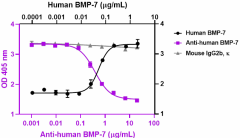- Clone
- A17135E (See other available formats)
- Regulatory Status
- RUO
- Isotype
- Mouse IgG2b, κ

-

Recombinant human BMP-7 (Cat. No. 595602) (black circles) induces the differentiation of ATDC5 mouse chondrogenic cells. Ultra-LEAF™ purified anti-human BMP-7 antibody (clone A17135E) (purple squares) inhibits the effect of recombinant human BMP-7 at 0.2 µg /mL on ATDC5 cells in a dose- dependent manner, whereas the GoInVivo™ purified mouse IgG2b, κ isotype ctrl antibody (gray triangles) (Cat. No. 400366) does not have the effect. ND50 range: 0.3 - 1.5 μg/mL.
| Cat # | Size | Price | Quantity Check Availability | ||
|---|---|---|---|---|---|
| 946903 | 100 µg | $358.00 | |||
| 946904 | 1 mg | $1205.00 | |||
Select size of product is eligible for a 40% discount! Promotion valid until December 31, 2024. Exclusions apply. To view full promotion terms and conditions or to contact your local BioLegend representative to receive a quote, visit our webpage.
Bone morphogenetic proteins (BMPs) belong to the transforming growth factor beta (TGF-β) superfamily. BMPs play a key role in embryonic development, especially during heart, neural and cartilage development. Around 20 BMP family members have been identified and characterized. BMPs signal through serine/threonine kinase receptors, and are composed of type I and II subtypes. Four type I receptors have been identified: type IA and IB BMP receptors, type IA activin receptor, and activin receptor-like kinase I. Three type II receptors have also been recognized: type II BMP receptor and type II and IIB activin receptors. BMP-7, originally identified by its properties to induce bone formation, has been identified as an anti-fibrotic molecule, antagonizing TGF-β1. Fibrosis is associated with the emergence of fibroblasts derived from endothelial cells, suggesting an endothelial-mesenchymal transition (EndMT). TGF-β1 induces endothelial cells to undergo EndMT, whereas bone BMP-7 preserved the endothelial phenotype. BMP-7 inhibits fibrosis in the kidney, lung, liver, heart, peritonium, oral submucosa tissue, and colonic wall.
Product Details
- Verified Reactivity
- Human
- Antibody Type
- Monoclonal
- Host Species
- Mouse
- Immunogen
- Recombinant human BMP-7
- Formulation
- 0.2 µm filtered in phosphate-buffered solution, pH 7.2, containing no preservative.
- Preparation
- The Ultra-LEAF™ (Low Endotoxin, Azide-Free) antibody was purified by affinity chromatography.
- Concentration
- The antibody is bottled at the concentration indicated on the vial, typically between 2 mg/mL and 3 mg/mL. Older lots may have also been bottled at 1 mg/mL. To obtain lot-specific concentration and expiration, please enter the lot number in our Certificate of Analysis online tool.
- Storage & Handling
- The antibody solution should be stored undiluted between 2°C and 8°C. This Ultra-LEAF™ solution contains no preservative; handle under aseptic conditions.
- Application
-
Block - Quality tested
- Recommended Usage
-
Each lot of this antibody is quality control tested by neutralization of differentiation induced by recombinant human BMP-7 (Cat. No. 595602) at 0.2 µg/mL on ATDC5 mouse chondrogenic cells. ND50 range: 0.3-1.5 µg/mL. It is recommended that the reagent be titrated for optimal performance for each application.
- RRID
-
AB_2894547 (BioLegend Cat. No. 946903)
AB_2894547 (BioLegend Cat. No. 946904)
Antigen Details
- Structure
- Growth factor, homodimer
- Distribution
-
Widely expressed
- Function
- BMP-7 promotes bone formation; BMP-7 induces Langerhans cell differentiation and proliferation, induces brown adipocyte differentiation and thermogenesis, and it has antifibrotic properties.
- Interaction
- Osteoblasts, Langerhans cells, adipocytes, endothelial cells
- Ligand/Receptor
- BMP type-I receptor ALK3 and Type II BMP receptor
- Cell Type
- Embryonic Stem Cells, Hematopoietic stem and progenitors, Mesenchymal Stem Cells, Neural Stem Cells
- Biology Area
- Angiogenesis, Apoptosis/Tumor Suppressors/Cell Death, Cell Biology, Neuroscience, Stem Cells, Synaptic Biology
- Molecular Family
- Cytokine/Chemokine Receptors, Growth Factors, Tumor Suppressors
- Antigen References
-
- Chen D, et al. 2004. Growth Factors 22:233.
- Tseng Y, et al. 2008. Nature 454:1000.
- Zeisberg E, et al. 2007. Nat. Med. 13:952.
- Hao ZM, et al. 2012. Mol. Ther. 20:2043.
- Yasmin N, et al. 2013. J. Exp. Med. 210:2597.
- Gene ID
- 655 View all products for this Gene ID
- UniProt
- View information about BMP-7 on UniProt.org
Other Formats
View All BMP-7 Reagents Request Custom Conjugation| Description | Clone | Applications |
|---|---|---|
| Ultra-LEAF™ Purified anti-human BMP-7 Antibody | A17135E | Neut |
Compare Data Across All Formats
This data display is provided for general comparisons between formats.
Your actual data may vary due to variations in samples, target cells, instruments and their settings, staining conditions, and other factors.
If you need assistance with selecting the best format contact our expert technical support team.
-
Ultra-LEAF™ Purified anti-human BMP-7 Antibody

Recombinant human BMP-7 (Cat. No. 595602) (black circles) in...
